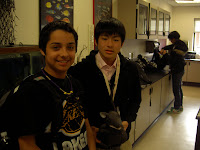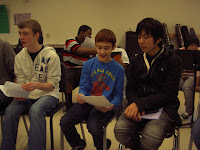
I was in the middle of another round of revisions courtesy of my amazing editor, Mary Kate Castellani, and I had a thought...
Wait, didn't I have a blog?
So I dug my way out of the 300 + pages I was working through and I discovered that yes, my blog is still here, and waiting for me are my loyal blog followers, wondering why I hadn't posted for so long. The answer can be summed up in one word...
REVISIONS
I remember a while back reading a
Nathan Bransford post about being a professional reviser, and I'm beginning to see what he meant. It reminds me of the time several, (more than I want to think about), years ago when I was in college, being trained as a disc jockey for a student radio station. Now being a dj in college sounds cool, but when I was being trained, the guy training me told me that really, I was just a glorified button pusher. He was right, one button turned on the musi

c, one button played a commercial, one button played the news. And if I was feeling really brave, there was even a button that put my voice out on the air for all of campus to hear. (Or the dozen or so listeners our little station had. Hey, that kind of reminds me of my blog... but I digress.)
My point is, saying I'm an author sounds a lot better than saying I'm a reviser, but if you're an author, you know that writing (as in first getting the story on paper) is just a small part of the process.
I'm on my third round of revisions with my editor. Before that I had at least four different drafts that I did on my own and with my critique group. Then I had a couple of rounds with my agent. All of that, (I've since learned) was just the tip of the iceberg.
I'm amazed at what I have learned in this process with a professional editor.
WOW!

The first lesson (that I thought I had already learned) is:
REVISIONS ARE HARD!
I have never strained my brain, or tried to keep my thoughts straight, or worked my imagination harder than I have in the last couple of months. I've learned so much about plot and pacing and character building and setting. It's been hard, but I'm so grateful for the guidance of an editor like Mary Kate. She comes up with plot holes and questions and ideas that I hadn't ever noticed or thought of. She has been patient and supportive with my trial and error. I feel like I'm taking an intensive writing course with a private tutor.
The second lesson I learned:
REVISIONS ARE FUN!
As hard as it is, I love going back to visit my characters and my world. I love finding out how much my main character can take. (Are all authors sadistic by nature or is it just me?) I love rearranging scenes and chapters and making the plot stronger. I'm going to have a hard time letting go of this story and these characters and calling the book done. (And no, I don't see a sequel anywhere in this.) The journey has been incredible.
Some things I've learned along the way:
Seeing the big picture helps. I followed a Laurie Halse Anderson revision tip and outlined my entire story in a way I could see it. Instead of using a big piece of paper, like she suggests, I laid the whole manuscript out over my living room. (My family was banned from that room for a few days.) I wrote down the main part of each chapter, what important things happened, and whether the tension increased, decreased, or stayed neutral. I stacked the pages in terms of mini-story arcs. With it all in front of me I could see better what could be cut, what could be combined, and what could be rearranged. (I also used a story map that my lovely edito

r had provided for me.)
Seeing everything laid out helped my brain keep track of 331 pages of characters, plot twists, story arcs, and especially pacing.
I'm happy to say I'm down to what feel like minor edits. It's been a long process, a hard process, a fun process, and above all a learning process. Thanks to the revisions I've done on this manuscript I feel like every story I write will be stronger.
I'm heading back to my revisions. I'll miss all of my loyal followers. Hopefully it won't take me so long to make it back to my blog again.
What about you? How do you revise? Are you a visual revisionist, a hold-it-all-in-your head revisionist, or a seat of your pants revisionist?
 Today our Japanese students attended American school for the first time. They went to Chinook Middle school and spent the day shadowing an American student. For most of the students, they spent the day with their host brother or sister. Those who didn’t have a host brother or sister at Chinook were assigned a “buddy”.
Today our Japanese students attended American school for the first time. They went to Chinook Middle school and spent the day shadowing an American student. For most of the students, they spent the day with their host brother or sister. Those who didn’t have a host brother or sister at Chinook were assigned a “buddy”. 























